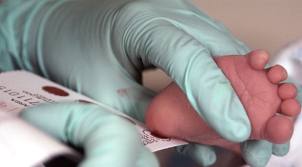Learning Disability
TweetLearning Difficulties in children is a common phenomenon. There are issues in the way children learn and grasp the world around them - academic or natural or social. Many of these disabilities are from unknown origin (genetic, by birth, etc.) See some of the varied types of genetic illnesses in the following page.
This section of learning disabilities is concerned with a general outline of the features, epidemiology and aetiology of learning disabilities, the organization of services and, more specifically, with the psychiatric disorders affecting these people.
Many of the psychiatric problems of children with learning disabilities are similar to those of children of normal intelligence; an account of these problems is given in the section on child psychiatry.
Top Stories in Learning Disability
 Fragile X Syndrome - also termed Martin-Bell syndrome or marker X syndrome most common known cause of inherited intellectual disability. Fragile X Syndrome - also termed Martin-Bell syndrome or marker X syndrome most common known cause of inherited intellectual disability. |
 Tay Sachs Disease- also known as GM2 gangliosidosis or hexosaminidase A deficiency, disorder typically appear normal until the age of 3 to 6 months. Tay Sachs Disease- also known as GM2 gangliosidosis or hexosaminidase A deficiency, disorder typically appear normal until the age of 3 to 6 months. |
|
 Spina bifida - birth defect that involves the incomplete development of the spinal cord or its coverings. Spina bifida - birth defect that involves the incomplete development of the spinal cord or its coverings. |
 Down's Syndrome - also called Trisomy 21 is a genetic disorder that occurs in approximately 1 of 800 live births. Down's Syndrome - also called Trisomy 21 is a genetic disorder that occurs in approximately 1 of 800 live births. |
|
 Phenylketonuria -
rare metabolic disorder in which the body can't process part of a protein called phenylalanine. Phenylketonuria -
rare metabolic disorder in which the body can't process part of a protein called phenylalanine. |
 Mental Retardation-
disorder character, Step by Step efforts to the Children with Mental Retardation by cognitive delays. Mental Retardation-
disorder character, Step by Step efforts to the Children with Mental Retardation by cognitive delays. |
More on Learning Disability
- Learning Disability
- Mental Retardation
- Type of learning disability
- Cause of mental retardation
- Mild mental retardation
- Down's Syndrome
- Fragile X Syndrome
- Edward's Syndrome
- Patau's Syndrome
- Phenylketonuria
- Homocystinuria
- Hurler Syndrome
- Tay Sachs Disease
- Lesch-Nyhan syndrome
- Neurofibromatosis (von Recklinghausen's syndrome)
- Cri du chat Syndrome
- Lawrence-Moon-biedl syndrome
- Rubella embryopathy
- Cytomegalovirus
- Tuberose Sclerosis (epiloia)
- Congenital Syphilis
- Toxoplasmosis
- Hydrocephalus
- Hypothyroidism (cretinism)
- Spina bifida
- Hyperbilirubinaemia
- Cerebral palsy
- Microcephaly
Epidemiology of learning disability
In 1929, in an important survey of schoolchildren in six areas of the UK, E. O. Lewis found that the total prevalence of mental retardation was 27 per 1000, and the prevalence of moderate and severe learning disability (IQ less than 50) was 3.7 per 1000. Subsequent studies in many countries have broadly confirmed these early findings. In the population aged 15-19, the prevalence of moderate and severe learning disabilities is between 3.0 and 4.0 per 1000. The prevalence of moderate and severe learning disability has changed little since the 1930s. However, incidence of severe learning disability has fallen substantially, because antenatal, natal, and neonatal care have improved. The reason that prevalence has not changed is because patients are living longer, particularly those with Down's syndrome. This change has also affected the age distribution of people with severe learning disability, so that the numbers of adults have increased (see Fryers 2000 for a review of epidemiology).
Tizard (1964) drew attention to the distinction between 'administrative' prevalence and 'true' prevalence. He defined administrative prevalence as 'the numbers for whom services would be required in a community which made provision for all who needed them'. If the true prevalence of all levels of learning disabilities (IQ less than 70) is 20-30 per 1000 of the population of all ages (Broman et al. 1987), then the administrative prevalence is about 10 per 1000 of all ages. In other words, less than half of all such people require special provision. Administrative prevalence is higher in lower socioeconomic groups and in childhood when more patients need services. It falls after the age of 16 ( Richardson 1992) because there is continuing slow intellectual development and gradual social adjustment.


Sometimes crying or laughing
are the only options left,
and laughing feels better right now.

Current Issue
 Self Help Leaflets Take the help of our self help leaflets or booklets. |
 The DG Magazine All about living with depression |
Learning Disability
- Learning Disability
- Mental Retardation
- Type of learning disability
- Cause of mental retardation
- Mild mental retardation
- Down's Syndrome
- Fragile X Syndrome
- Edward's Syndrome
- Patau's Syndrome
- Phenylketonuria
- Homocystinuria
- Hurler Syndrome
- Tay Sachs Disease
- Lesch-Nyhan syndrome
- Neurofibromatosis (von Recklinghausen's syndrome)
- Cri du chat Syndrome
- Lawrence-Moon-biedl syndrome
- Rubella embryopathy
- Cytomegalovirus
- Tuberose Sclerosis (epiloia)
- Congenital Syphilis
- Toxoplasmosis
- Hydrocephalus
- Hypothyroidism (cretinism)
- Spina bifida
- Hyperbilirubinaemia
- Cerebral palsy
- Microcephaly
- Dyslexia












